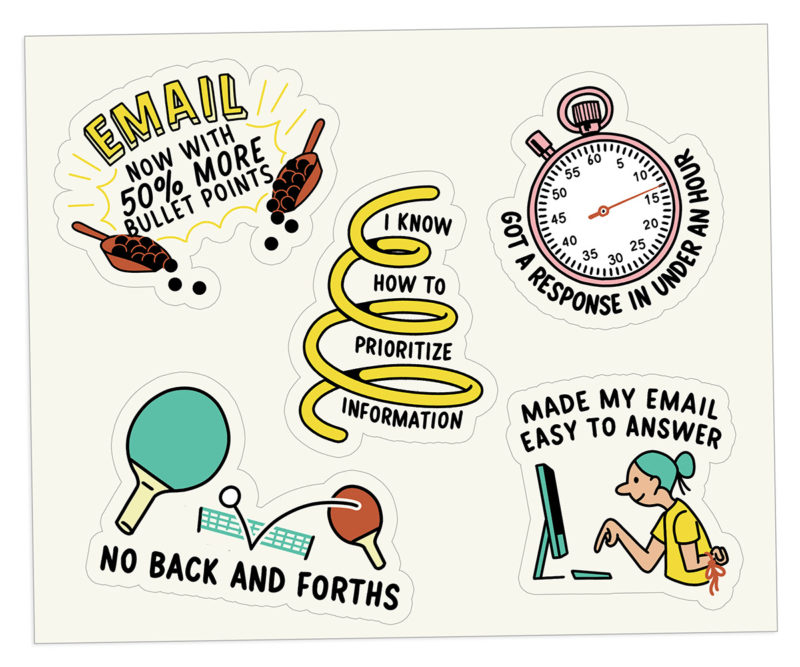Hi Andy and Emma!
I’m curious: What are your thoughts on introducing yourself and your role when emailing someone for the first time? This normally happens when I need something from them. For example, “Hi Paul, my name is Claire and I’m a product manager for XYZ. I am seeking your input on ABC…” versus “Hi Paul, I am seeking your input on ABC…”
Emma: What you’re asking about is context. How much of it do you need to convince someone to fulfill your request?
Andy: And which comes first, the request or the context?
Emma: I’ve written about a million emails that start Hi, my name is Emma. I do these things in this capacity. I don’t think it’s bad or wrong, and I don’t think anyone receiving an email that starts with an introduction will bat an eye. That being said, introductions aren’t terribly compelling context, unless your name and title carry a great deal of weight: Hi, my name is Emma and I’m your new boss.
Andy: I get the impulse. Often, a big part of my context is that I’m a reasonable person who’s worthy of help — introducing myself goes hand-in-hand with being human. But email signatures take care of all that for us. I’ve learned people are much more apt to help me out if I make my email requests easy to answer.
Emma: Agreed! The biggest risk of any email is burying the lede. We’ve all gotten something like this in our inbox:
Hi, my name is Ryan, and I’m the product manager working on the new feature rollout. I’m looking for input on our announcement strategy. You worked on the last rollout, right? We’re having a review with leadership next week and I wanted to bounce some ideas off you. Is this plan (see attached) the final plan you used for your rollout? Kelly on the dev team sent it my way and I’ve been using it as a reference. Did you get good PR pickup from the blog post, or was there a separate PR strategy? How many outlets? Any other advice you have would be greatly appreciated!
Thanks,
Ryan
Product Manager, New Feature Rollouts
Andy: Just glancing at that paragraph has a near hypnotic effect on me. It’s a sentence soup of specific questions, open-ended requests, random context — leadership reviews, appreciation, someone named Kelly. The amount of effort it would take for me to unravel what this person really wants just isn’t worth it. I’m getting very sleepy…
Emma: We’ve written before about knowing what response you’re looking for and asking for it. Same rules apply here. If poor Ryan just needs to confirm the number of outlets that picked up a feature rollout announcement:
Subject: PR results from last year’s feature rollout
Hi,
I’m the product manager on the new feature rollout — trying to lock down the announce strategy to present to leadership next week. Two questions:
1. How many outlets picked up last year’s feature rollout announcement?
2. Was this blog post the only announcement? Or was there a press release and social campaign as well?
Thank you,
Ryan
Product Manager, New Feature Rollouts
Andy: So much white space! Such simple questions! I don’t need a ton of context to convince me to respond to this email, simply because I could answer it with one hand tied behind my back.
Now compare that to if Ryan’s hoping to download with last year’s PM and get live feedback on his ideas:
Subject: 30-minute feedback meeting? No prep required
Hi,
I’m working on the new feature rollout. I’ve been using your strategy from last year as a reference and it’s been so helpful.
Do you have 30 minutes available this week? (No prep required.)
I’d love to walk you through my ideas and have you poke holes in it and ask questions, so I can revise before my review with leadership next week.
Thank you,
Ryan
Product Manager, New Feature Rollouts
Emma: When you’re asking for a favor, a little bit of flattery really does go a long way. Being sought after and complimented is compelling context.
Andy: As is an explicit time cap and guarantee that they’re not suddenly going to have a lot more work on their plate.
If we’re making it sound like an email can only have one request in it at a time — we know that’s not realistic. There’s a good chance that Ryan needs to confirm the results from last year’s rollout and also wants to have an in-person download. The more tasks there are to fulfill, the more important formatting is: all requests live at the top of the email, ideally in bullet points.
Emma: It’s not a very conversational way to start an email, but I try to remember that whoever is on the receiving end has a limited attention span and a limited amount of care for the quest I’m on. Do I hope they read every word of the 400-word email I just spent 45 minutes crafting? Sure.
Andy: Will they? Not a chance. Putting everything you need from your reader up top means they’ll see it before they bail. I think of emails in loops, like an article in the newspaper: the smallest loop at the top has the need-to-know information, the second loop below builds out additional context, the third loop is nice-to-know, and so on.
Emma: If every word of your email is need-to-know, you’d better have a pretty compelling reason for them to read the whole thing. If that’s your name and job title, or your boss’ name, or the project you’re working on, definitely include that information early.
Andy: Maybe add in a cash prize?
Emma: I mean, it couldn’t hurt.
Good Boss Achievement Stickers: Email Ask Edition


